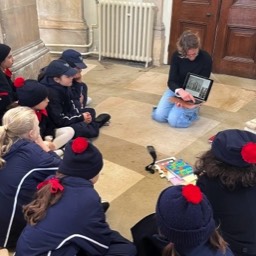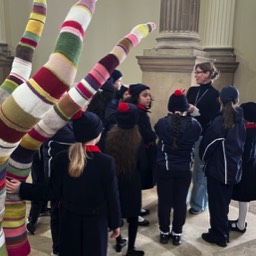
Engaging School Children - Rachel Goodsion (Artist in Residence)
I was thrilled to begin my residency with an installation in the Chapel called ‘Hatchings’. This piece is formed from eight-foot high, brightly-coloured ‘feelers’, each shape knitted and supported by an internal structure of wire so that each one can be altered and arranged.
Nearly 300 people visited the exhibition - an incredible number for mid-week. Three school groups also visited, mostly primary school age. Children are gold dust to artists as their reactions are immediate and genuine, engaging with art at a pure sensory level. Sure enough, they raced into the space, reaching out to touch and feel the shapes. Not surprising as they are knitted, stuffed and squashy like cuddly toys, inviting and familiar.
When explaining art to younger children, the key is to capture their imagination, to include physical actions to raise their energy, and to encourage them to make art themselves, becoming active participants in the experience rather than passive onlookers.
I also have to be very clear about what I would like the audience to feel, looking at the work. With ‘Hatchings’, my intention was for viewers to experience a sense of community, nature, and hope and warmth. These are all elements I feel are reflected in the Cemetery and the Chapel.
How did I go about this?
I placed the shapes closely together at the centre of the geometric floor, like creatures, huddled together. The ‘feelers’ are on a human scale so that people directly relate to them - they are their own ‘community’. The installation is also knitted using bright, stripy colours, promoting a feeling of warmth. And they reached upwards towards the Dome, an uplifting movement of hope. Finally nature – each person saw something slightly different – ‘saplings’ said one, ‘a glade’ said another, ‘a giant anemone’, ‘legs kicking in the sky’, ‘underwater seaweed moving with the current’. Every now and then, the tentacles moved in the breeze flowing through the great wooden doors, swaying gently, like a giant living creature.
I wanted the children to experience what is happening inside their bodies when they look at art and to understand that artists intentionally use colour, form, texture and movement to create these reactions. They had already sensed the warmth of the knitted texture. We looked at artists including Niki de St Phalle and Picasso: bright sculptures (‘happy’ they called out) and paintings with dark, scoured marks of red and strange, bizarre shapes (‘sad, scary, angry!’). Colour has an effect on all of us and makes us feel things.
On to shapes. They have an effect on us as well, but how to convey that to children? We all stood up and stretched up high with our arms above our heads. How does that make you feel?’ I asked, ‘strong or weak?’ ‘Strong!” they shouted. We then flopped down, bending at the waist and letting our arms go limp, brushing the floor. ‘And that?’ ‘Floppy, not strong!’ they answered. I then asked them what they thought of the installation, and they responded, (strongly primed!) ‘happy, playful, colourful strong!’
I am a great believer that in order to make an impact with art you have to actively engage the viewers and make them curious to find out more. To test my work out on children, the best critics there are, is an incredible opportunity. There will be more school visits to my next exhibition ‘Guardian Angels’ in the Chapel, and in April I will be speaking to Queens Gate about my residency, and the artistic themes I am exploring.
Instagram: rachelgoodison1
Photographs: Rachel Goodison
More posts
The Friends of Brompton Cemetery
North Lodge East Wing
Old Brompton Road
London SW5 9JE
Tel: +44 (0) 20 3876 4278


